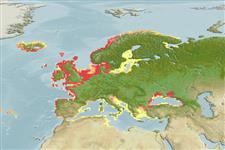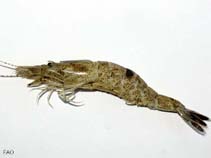Crangon crangon (Linnaeus, 1758)
Common shrimp| Native range | All suitable habitat | Point map | Year 2050 |

|
| This map was computer-generated and has not yet been reviewed. |
| Crangon crangon AquaMaps Data sources: GBIF OBIS |
رده بندی / Names اسامي عام | مترادف | CoL | ITIS | WoRMS
Malacostraca | Decapoda | Crangonidae
Environment: milieu / climate zone / تغييرات عمق / distribution range بوم شناسي
; لب شور; تغييرات عمق 0 - 50 m (مرجع 434). Subtropical, preferred 11°C (مرجع 107945); 74°N - 23°N, 16°W - 44°W
Distribution كشورها | مناطق سازمان خوار و بار جهاني (FAO) | Ecosystems | ظهور | معرفي
Northeast Atlantic and the Mediterranean.
Length at first maturity / Size / Weight / سن
بلوغ: Lm ? range ? - ? cm Max length : 8.9 cm TL جنس نر / بدون خواص جنسي; (مرجع 434)
Life cycle and mating behavior بلوغ | تولید مثل | تخم ریزی | Eggs | Fecundity | Larvae
مآخذ اصلی
مراجع | هماهنگ كننده | همكاران
Fischer, W., G. Bianchi and W.B. Scott (eds.) 1981 Shrimps and prawns. 6: pag.var. In FAO species identification sheets for fishery purposes. Eastern Central Atlantic (Fishing Area 34, 47; in part). Canada Funds-in-Trust. Ottawa, Department of Fisheries and Oceans Canada, by arrangement with the Food and Agriculture organization of the United Nations. 1-7: pag.var. (مرجع 434)
وضعيت در فهرست قرمز IUCN
(مرجع 130435: Version 2025-1)
وضعيت از نظر سايتس (مرجع 108899)
CMS (مرجع 116361)
خطر برای انسان ها
استفاده انسانی
ماهي گيري – شيلات: تجاري
FAO - ماهي گيري – شيلات: landings, نمايه گونه | FishSource | Sea Around Us
ابزارها
اطلاعات بيشتر
منابع اينترنتي
BHL | BOLD Systems | CISTI | DiscoverLife | FAO(ماهي گيري – شيلات: نمايه گونه; publication : search) | Fishipedia | GenBank (ژنوم, نوکلئوتيد) | GloBI | Gomexsi | Google Books | Google Scholar | Google | PubMed | Tree of Life | Wikipedia (برو, جستجو) | Zoological Record



